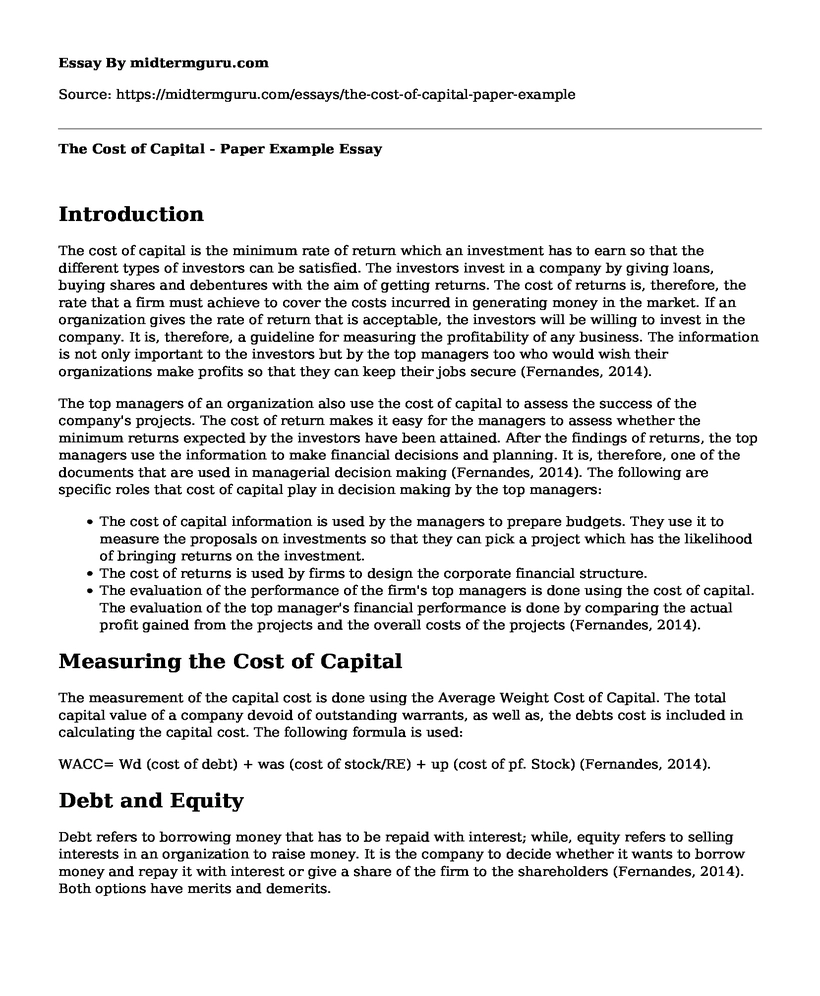Introduction
The cost of capital is the minimum rate of return which an investment has to earn so that the different types of investors can be satisfied. The investors invest in a company by giving loans, buying shares and debentures with the aim of getting returns. The cost of returns is, therefore, the rate that a firm must achieve to cover the costs incurred in generating money in the market. If an organization gives the rate of return that is acceptable, the investors will be willing to invest in the company. It is, therefore, a guideline for measuring the profitability of any business. The information is not only important to the investors but by the top managers too who would wish their organizations make profits so that they can keep their jobs secure (Fernandes, 2014).
The top managers of an organization also use the cost of capital to assess the success of the company's projects. The cost of return makes it easy for the managers to assess whether the minimum returns expected by the investors have been attained. After the findings of returns, the top managers use the information to make financial decisions and planning. It is, therefore, one of the documents that are used in managerial decision making (Fernandes, 2014). The following are specific roles that cost of capital play in decision making by the top managers:
- The cost of capital information is used by the managers to prepare budgets. They use it to measure the proposals on investments so that they can pick a project which has the likelihood of bringing returns on the investment.
- The cost of returns is used by firms to design the corporate financial structure.
- The evaluation of the performance of the firm's top managers is done using the cost of capital. The evaluation of the top manager's financial performance is done by comparing the actual profit gained from the projects and the overall costs of the projects (Fernandes, 2014).
Measuring the Cost of Capital
The measurement of the capital cost is done using the Average Weight Cost of Capital. The total capital value of a company devoid of outstanding warrants, as well as, the debts cost is included in calculating the capital cost. The following formula is used:
WACC= Wd (cost of debt) + was (cost of stock/RE) + up (cost of pf. Stock) (Fernandes, 2014).
Debt and Equity
Debt refers to borrowing money that has to be repaid with interest; while, equity refers to selling interests in an organization to raise money. It is the company to decide whether it wants to borrow money and repay it with interest or give a share of the firm to the shareholders (Fernandes, 2014). Both options have merits and demerits.
Advantages and Disadvantages of Equities Compared to Equity
Advantages
- Since the lender does not claim equity in the firm, debt does not affect the firm's ownership.
- The lender is just expected to repay the principal agreed upon and the interest and cannot claim the company's future interests
- The principal and the interests are known amounts that be panned earlier on repayment.
- The actual cost of the loan can be reduced by deducting it from the tax return of the firm.
- Raising the capital through debt is easier because there are no statutory requirements that have to be compiled to (Fernandes,2014).
Disadvantages
- The higher interest rates charged on debts during the time of crisis can lead to a company's solvency.
- The debt affect the growth of firms that are highly leveraged
- The flow of cash is needed for the interest and principal and must be budgeted for hence affecting the operations of the company
- The instruments of debt have restrictions on the firm's activities which prevents the management from getting loans from elsewhere.
- The firm that borrows is expected to have its assets as collateral which is sometimes risky if the company is unable to repay (Fernandes, 2014).
Conclusion
The debt offerings are more common than the equity offerings because, firstly, they do not make the company give up ownership. Secondly, the debt offerings are usually larger because it is a bit easier to pay interests on a loan than raising income through the issuance of equities. Finally, some companies may not have the growth potential or assets to enable it to raise enough capital for equity. However, it is easier to get debt it needs to convince the investors that it can make payment interests (Fernandes, 2014). After a thorough analysis, the firms opt for debts.
Reference
Fernandes, N. (2014). Finance for Executives: A practical guide for managers. Routledge, New York.
Cite this page
The Cost of Capital - Paper Example. (2022, Oct 01). Retrieved from https://midtermguru.com/essays/the-cost-of-capital-paper-example
If you are the original author of this essay and no longer wish to have it published on the midtermguru.com website, please click below to request its removal:
- Answers to Questions About Auditors Liability and Independence
- Should the Activities of Banks Be Regulated to Avoid Another Global Recession?
- Questions and Answers on Capital Budgeting - Paper Example
- Important Factors You Need to Know Before Investment - Essay Sample
- Paper Example on Investment Restrictions
- The Future of Currency - Essay Sample
- Tax Cuts & Jobs Act: Impacts on US Tax Codes & Economy - Research Paper







